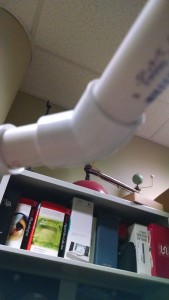Now that modern technology has advanced to the state where anyone can have a reasonably priced digital audio workstation at home, we’re now looking for ways to transform these home recording studios into spaces with the best possible acoustic capabilities. After all, you can have a decent DAW but you still have to get the best sounding audio into the workstations. If your initial recordings are junky then you’re going to have to work a lot harder to make those junky sound wavs sound presentable. As the adage goes, “you can cover shit with chocolate but it still tastes like shit.” Well, guitarists and bass players have it easy with VST plug-ins and amp modeling. Drummers and singers, on the other hand, are a different story. For the most part, drummers and vocalists/voice-over artists still use their room space to record acoustically. A voice-over artist or vocalist needs a booth of some kind for the cleanest and best possible recording. Well, here’s how I created my own vocal booth in my office that can easily be broken down and moved to a different location. And I did this for under $50.
My home studio is basically a converted garage. When I bought the house, the previous owners converted the garage into a hair salon. I, in turn, converted that hair salon into a recording studio. It’s still relatively small but it has the space to fit a full drumset, my guitar and bass gear, keyboards, and my DAW bench. Also, I have to have a couch, TV, and storage space. You must, you must.
I have a day job where I work on audio production for planetarium shows. Before moving into the position of Planetarium Producer I had an office right below a vocal isolation room, dedicated to just voice-over performance recording. This booth was directly above my office and easy to get wires passed down.
Then I moved into the position of Planetarium Producer and had to move offices. My vocal booth and recording studio moved, too. I had to figure out a way to get the same quality voice-over recording but in my office space.
That’s when I came up with the idea to make a portable voice over booth.
It was so easy to make and assemble I’m passing the knowledge on to you. Because I looked up vocal booths online and they’re not cheap. Basically, all you’re really trying to do–when recording–is getting the voice not to bounce all over the room. You want a dry, clean recording. That way you can add reverb and whatever other effects you want afterwards. You add these effects to the dry recording because you don’t want to add reverb to an already reverby sounding room.
You also want to eliminate any outside noise. You don’t want a good vocal take to be ruined by a passing truck, the air conditioner kicking on, or someone closing a door in the other room.
The idea for the construction of my vocal booth came to me after I moved into my house. I used my moving blankets to sound proof my house by placing them into my window frames. This not only helped isolate the sound into my house but it also kept out the light so I can sleep better. Moving blankets are thick, dense blankets used to pad furniture when moving from home to home.
 My vocal booth design can be easily changed to fit your own needs. I made my vocal booth tall and wide enough to fit in my office, by my desk, and suited for me to use while I’m seated. My home recording studio is easy to use while either standing or sitting; however, my office recording studio in the planetarium is best used while sitting down. So I record all my voice-over stuff while seated. This way I can easily stop a take, go back, re-record, edit, swivel my chair to do a quick pick-up. You get the idea.
My vocal booth design can be easily changed to fit your own needs. I made my vocal booth tall and wide enough to fit in my office, by my desk, and suited for me to use while I’m seated. My home recording studio is easy to use while either standing or sitting; however, my office recording studio in the planetarium is best used while sitting down. So I record all my voice-over stuff while seated. This way I can easily stop a take, go back, re-record, edit, swivel my chair to do a quick pick-up. You get the idea.
 The pic on the left is basically my finished product. You can see my MIDI keyboard there and the monitors I use. I removed the microphone stand so you can get a better look at it. But, basically, it’s a wall enclosure that blocks my right-hand side and the front. I also wanted to be able to move it in front of my couch or a stool in front of my desk if I’m recording someone else.
The pic on the left is basically my finished product. You can see my MIDI keyboard there and the monitors I use. I removed the microphone stand so you can get a better look at it. But, basically, it’s a wall enclosure that blocks my right-hand side and the front. I also wanted to be able to move it in front of my couch or a stool in front of my desk if I’m recording someone else.
 This is what the skeleton of the booth looks like. It’s made out of PVC pipes which were easily cut to the dimensions I wanted. You can see that there is a middle section (or a sternum) and two “wings” that slightly wrap towards the left and right shoulders.
This is what the skeleton of the booth looks like. It’s made out of PVC pipes which were easily cut to the dimensions I wanted. You can see that there is a middle section (or a sternum) and two “wings” that slightly wrap towards the left and right shoulders.
This is a very light-weight and easily transportable configuration and it can be stored out-of-sight when not in use.
So here’s how I made it:
 You’ll see that it’s really only made of three pipe sizes. Ten pipe cuts; three different sizes.
You’ll see that it’s really only made of three pipe sizes. Ten pipe cuts; three different sizes.
You have the four vertical slats that are the longest pipes. Then you have the top and bottom, shorter pieces that create the top and bottom parts of the left and right wings. And then you have the top and bottom pipes that create the top and bottom of the middle section. Connecting them all together are three different angled elbow joints.
Everything snaps into place: no screws, no glue.
The only thing I used was a coping saw to cut the pipes to the sizes I wanted. You can use any saw for cutting plastic, I just had a coping saw at the ready.
Look at that skeleton picture again. There are really three wall faces. We’ll call the two wings that turn inwards wall A and B. We’ll call the middle section wall C.
The four long vertical slats that make up the height of the piece are all 60 inches.
The top and bottom pipes for wall A and B are 23 inches.
The top and bottom pipes for wall C are 21 inches.
That’s it for the pipes. I bought enough pipe so that I could cut 4 pipe-slats to be 60 inches. I then made sure I had enough to cut 4 top and bottom pipe-slats to be 23 inches. And then I cut 2 pipe-slats to be 21 inches.
Now all you need are the proper elbow connectors to make them all fit as a single skeletal piece. I bought:
4 – 90 degree elbows
4 – 45 degree elbows
4 – T-shaped connectors






So you can really come up with any height and width you want. You can dream up of some other style of bend or enclosure, too. If you want it to be a fully enclosed both you can do that as well. That’s the ease of working with the PVC pipes. They’re super easy to cut and cheap. They’re also sturdy enough to support the weight of the moving blankets.
 And that’s what I used to create the actually dampening walls.
And that’s what I used to create the actually dampening walls.
You can buy moving blankets from any variety of stores. I bought these at a place called Harbor Freight and they come in a wide variety of sizes and thickness.
I made sure to buy the taller ones because I knew that I might use them at my house as well.
At my home I actually have hooks on my ceiling and I hang a lot of these up from my ceiling to create a half-tube enclosure.
You could even come up with a way to make a head-space addition to this skeleton that could create an overhang type of thing to cut off influence from the ceiling.
 The only other thing I used in this model was larger alligator clips.
The only other thing I used in this model was larger alligator clips.
These things help to keep the blankets in place and from slipping down during the day. I clip the sides–not to the pipes themselves but I clip the blankets together. Also, when I drape two blankets and have them overlap, I’ll clip those together as well. These alligator clips are also very inexpensive to buy and can easily be stashed away in your desk when not using them.
And that’s really it, folks.
Whenever I’m done with all this I just pull the pipes out of the elbow joints and put it behind my office door. It’s super easy to make and quite useful. I’ve seen people making vocal booths out of old refrigerator boxes and I’ve seen tiny little voice box enclosures. But, for me, this is the cheapest and most efficient voice booth for what I need it for. The voice-overs I capture sound clean. It’s not what you’re going to get at a big studio with full enclosure but if you have to work on the cheap, then give this a shot.
 Like I said, this is the set-up I have at work and I really only use this particular configuration to record voice-over performance. At home, in my music recording studio, I have a very different configuration. Instead of making a PVC skeleton I have a system of hooks in my ceiling. I sewed loops onto the tops of my moving blankets to easily hang them from the hooks. If you don’t know how to sew then you can always poke holes in the blanket and get the same effect. The idea for my home recording booth was to have something that I could take down easily so it wouldn’t permanently be in the way.
Like I said, this is the set-up I have at work and I really only use this particular configuration to record voice-over performance. At home, in my music recording studio, I have a very different configuration. Instead of making a PVC skeleton I have a system of hooks in my ceiling. I sewed loops onto the tops of my moving blankets to easily hang them from the hooks. If you don’t know how to sew then you can always poke holes in the blanket and get the same effect. The idea for my home recording booth was to have something that I could take down easily so it wouldn’t permanently be in the way.








Very cool!
Great Idea and soooo simple.
Thank you for posting here